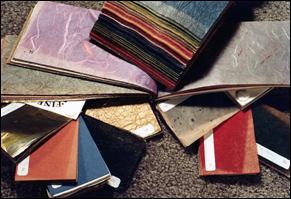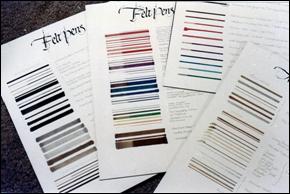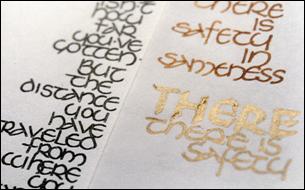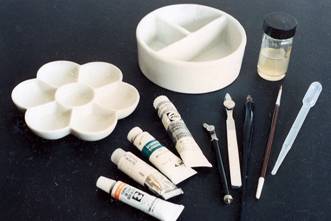 Photo 1
Photo 1
Dyes will lightfade under all light. Fluorescent light is 3x worse than tungsten light and sunlight is 6x worse than tungsten.
Lightfastness or light permanence is a product's resistance to change with exposure to light, primarily UV light. The degree of color permanence depends upon the specific medium being considered such as printing inks, color emulsions in photographs, mat board surface papers, fabrics or pigments used for surface decoration.
Mat board companies have strived for years to create quality surface papers resistant to light fading, bleeding and scuffing...it's their job! My concern in addressing the topic of lightfastness involves the many other materials often selected by framers used to enhance and decorate their mat boards and frames.
As frame designers we should be constantly searching for the ultimate in quality materials that are the most permanent and non-harmful. It's our job to protect and enhance the art we frame. We accept the fact that mat boards will lightly fade over time and that's probably good, if they remained perfect forever the artwork might never require rematting. Other media may also have some degree of fading, but we need to be aware of how much, how fast, and to what extent. Then we must decide if it is an acceptable degree or not.
Terminology
One of the largest sources of confusion lies in the basic terminology surrounding this issue. Lightfast means to hold its color for an acceptable period of time (as in mat boards). Fugitive means to run away or disappear too quickly for consideration. Permanent generally means waterproof, not lightfast, as in paints, inks and felt pens. Waterproof mediums will not wash off or bleed when exposed to moisture, but may not be lightfast. Acid-free...that's a whole other can of worms, but is often used in conjunction with describing papers and at least needed mentioning.
Artwork, photographs, mat boards and paper bevels are not the only sources of potential light fading or yellowing. Specialty papers and fabrics used to wrap mats, felt and metallic pens used for `quick fix' ruling lines and many bottled inks for calligraphy are often very light fugitive.
Artist pigments may even start off lightfast and become more fugitive when colors are mixed with them, as by creating tints from basic gouache colors by the addition of Permanent White rather than Zinc White (see "Gouache", PFM March 1992).
What is Light?
Light is made up of photons in an electromagnetic field. Ultraviolet radiation referred to as UV light begins the low end of the spectrum up to 400 nanometers (nm), visible light is what allows us to see colors and is on the spectrum between 400 and 700nm, and infrared radiation is found at levels of 700nm and higher.
Direct sunlight is the most damaging, only equaled to that of fluorescent lighting, containing 6 times more harmful UV rays than found in traditional tungsten bulbs. Daylight is second most harmful with 3 times the damaging potential. Followed by tungsten light which originates from regular light bulbs used in household lamps.
Although the above statistics reflect ultraviolet light damage, many highly fugitive pigments are drastically effected and damaged by visible light in the middle of the light spectrum. Visible light is what we need to register the familiar colors of the color wheel, and the only way to protect pigments sensitive to visible light is to cover them so we can't see their color. Sometimes the very light that makes it blue is the light that will damage it!
Papers sensitive to UV light damage may be helped by using UV filtering glazing, but pigments effected by visible light will not be helped. Acidic paper, which might be effected only by damaging UV rays may indeed be protected just fine, while certificates signed with fugitive inks susceptible to visible light will continue to fade.
Dyes as Colorants
The agents used to create colors determines its lightfastness. If a basic color is created through the mixing of dyes, the colors are often quite fugitive. Water-soluble dyes are generally not considered lightfast, they will fade by exposure to visible light (photo 1).
 Photo 1
Photo 1
Dyes will lightfade under all light. Fluorescent light is 3x worse than tungsten light and sunlight is 6x worse than tungsten.
Colored dyes are added during the initial papermaking or color mixing process. Felt pen and bottled fountain pen inks, tissue papers and many handmade rice papers are colored with these dyes also making them fugitive by nature. They were never intended for long term use, thus not requiring light permanence.
Water-insoluble dyes are much more lightfast, though they are often colors or patterns applied to existing pages. Many are top sized to sheets affixed with alum as a bonding agent. Traditionally hand-marbled papers and paste paper are good examples of this process and are considered quite lightfast.
Pigments
Carbon based inks are pigmented with soot binders making them very lightfast and the best choice for signing documents. On the other hand, permanent inks are made waterproof by the addition of shellac, not necessarily making them lightfast. Remember, permanent does not necessarily mean lightfast, only waterproof (photo 2). Look for permanent and lightfast on product labels.
 Photo 2
Photo 2
Felt pens are notoriously fugitive, as indicated by the faded strip on the left of each card.
Pigments are considered much more lightfast than dyes, but that depends upon their origin. — Natural materials, though ground into pigments are less lightfast than man-made ones. In fact roots, nuts and berries used to color inks throughout history are often considered stains rather than dyes, and fade as easily as flowers. Synthetics, such as acrylic, are chemically created and hold color well simply because of their non-organic origin, they're plastics and don't break down.
Metallics
Acrylics and tube metallics paints are more synthetic and do not appear to be effected when exposed to UV rays, they are often permanent, waterproof and lightfast. Metallic papers vary depending upon their composition and testing must be done to determine permanence. Metallic felt pens and bronzing powders are another story though. We have learned that real silver will tarnish over time, but synthetic silver inks stay bright and shiny even when exposed to UV rays. Unlike real gold, which holds its color, many gold inks are created by the addition of copper which will oxidize over time. Gold thus turns green even if never exposed to light, its an aging process stimulated more by time than light.
Metallic felt pens also have copper alloys. Oils may separate from them, gold will tarnish, but silver remains unchanged. Gold oil based felt pens, which come in many brands and sizes, will gradually turn from bright gold to orange to green to nearly black over a five year period (photo 3). Do not allow artists and photographers to sign images with them, and NEVER to use them for a "quick fix" ruling pen line on a mat!
 Photo 3
Photo 3
All three samples in the photo were written with the same Pilot Extra Fine Point Gold Marker. Lettering left has oxidized over a four year period, reacting to oxygen rather than sunlight.
Framer Beware!
When looking for pigments and medias to expand your creative venue be aware of the products. When selecting specialty papers for wrapping mats, tiered matting or shadow box designing, know how they will respond to both visible and UV light. Place sampler books in sunny windows for 1-3 months, or under UV grow lights both with UV glass and without to check the papers you wish to work with.
Stay away from felt pens of all types, its better to be safe than sorry. Translucent drawing and fountain pen inks are composed of dyes, think fugitive. The more opaque an ink or paint is the greater chance might have to be more lightfast since it is probably pigment and not dye. Tube gouache and watercolors often have permanency ratings stated on them (i.e. A,B,C,D) look for them and stay within the "A" permanency range or better. Gouache is a dependable opaque tube media well adapted to framing use for surface painting, bevels, ruling lines and calligraphy (photo 4). Another dependable media available in powder and liquid pigments are Mat Magic products which were developed for framers, are easy to work with and fit the long term lightfast requirements.
 Photo 4
Photo 4
Gouache is an opaque watercolor that comes in a tube, is lightfast and may be used for ruling lines, lettering and bevel painting.
Papers will be fugitive by the nature of the materials selected to make them. If naturally colored with flowers, plants, vegetables, herbs or bark, consider them as fugitive as any dyes. Simply because a paper is natural does not create longevity.
Light test all materials you are considering to use on a regular basis, and remember not to showcase techniques or materials you do not wish to sell, they will always be the ones most loved by your clients. The moral of the story...know your materials, and how they are effected by light. Work with media and materials you enjoy and always select the right thing for the job. Whether the color fades or remains for future generations, it's your reputation, and butt, on the line. One way or another, it'll all come back to you in the end!
END
Copyright © 1995 Chris A Paschke
For more articles on mounting basics look under the mounting section in Articles by Subject.
Additional information on all types of mounting is found in:
The Mounting and Laminating Handbook, Second Edition, 2002,
The Mounting And Laminating Handbook, Third Edition, 2008 and
Creative Mounting, Wrapping, And Laminating, 2000 will teach you everything you need to know about getting the most from your dry mount equipment and materials as an innovative frame designer.
All books are available from Designs Ink Publishing through this website.
Chris A Paschke, CPF GCF
Designs Ink
Designs Ink Publishing
785 Tucker Road, Suite G-183
Tehachapi, CA 93561
P 661-821-2188
chris@designsinkart.com